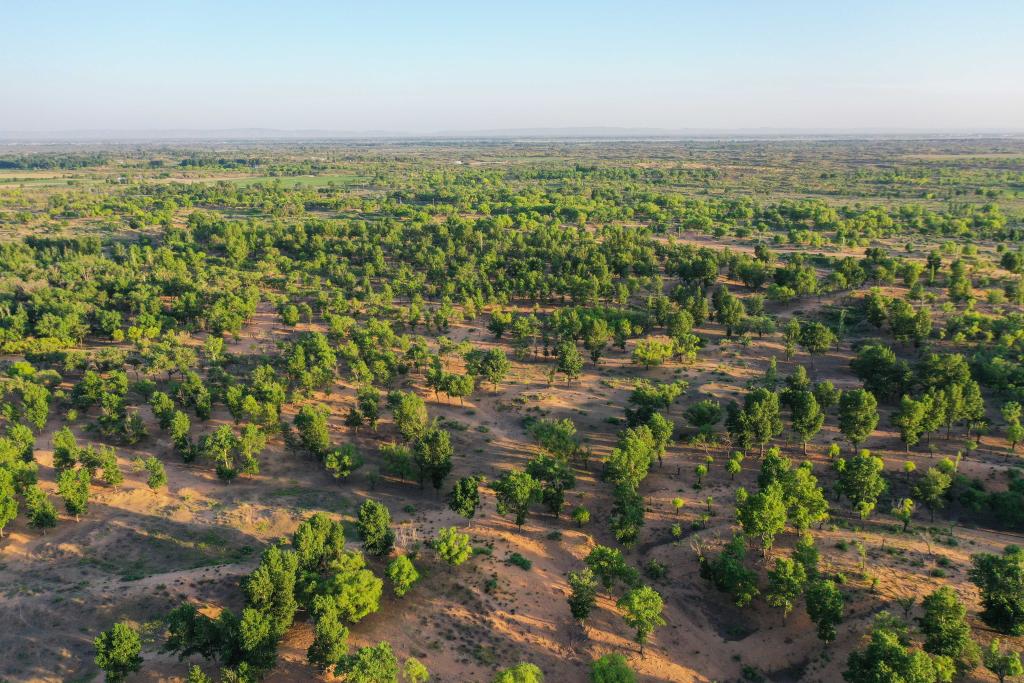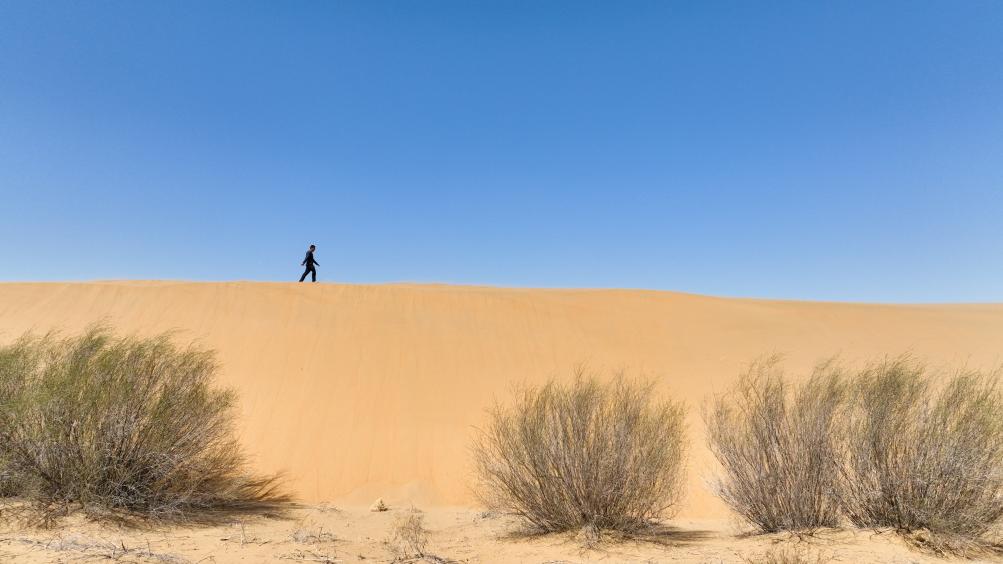
This is a wooded area (drone photo) taken in the Mu Us Sand on June 14, 2023. Photo by Xinhua News Agency reporter Liu Lei
In the deep winter, the edge of the Kubuqi Desert on the south bank of the Yellow River is busy. Sand prevention and control workers seize the opportunity to check for leaks and fill in the desert, and make up for the grass grid. After 50-year-old farmer Zhang Yong cleaned the wheat straw, he neatly placed it on the square edges drawn in advance on the sand, and then stepped on the edges with a shovel. The whole process was completed in one go.
Looking at the uniform grass grid, Zhang Yong smiled: "The grass grid is a sand control method that prevents wind and solidifies sand and cultivates moisture. The grass grid is repaired every winter, and they can firmly lock in the yellow sand in spring."
The Kubuqi Desert is the seventh largest desert in China, with a total area of 14,100 square kilometers. It is like a giant dragon lying across northern China.
Wurigen, who lives in the depths of the Kubuqi Desert, only one color is found in his childhood memory. "There is endless yellow sand on the stove and cabinet at home, and it's sand beams when you go out." Wurigen recalled that a folk song in my hometown sang, "The people in the sand are bitter, the people in the sand are tired, and there is no vegetation in the sky..." In order to effectively control the Kubuqi Desert, in the 1950s and 1960s, Inner Mongolia built three state-owned desert control stations with the strong support of the state and began to afforestate and control sand on the northern edge of the Kubuqi Desert. Since then, Wurigen’s hometown has gradually become green and vibrant.
"At that time, people regarded the governance of the Kubuqi Desert as a mission. The older generation finished doing it and the next generation continued to do it. There were more and more trees in the desert, and the ecological deterioration was effectively curbed." Wurigen said.

On April 11, 2024, a desert control man patrolled trees in the Kubuqi Desert in Dalat Banner. Photo by Xinhua News Agency reporter Li Zhipeng
As one of the provinces and regions with the most concentrated and most harmful desertified land in China, Inner Mongolia has regarded sand control as the main task of desertification prevention and control for many years, it has continued to fight the tough battle of the "Three Norths" project, vigorously promoted the natural forest protection project and the Beijing-Tianjin sand source control project, continued to implement the return of farmland to forests and grassland return to grassland, implemented the grass-live balance and grazing ban system, and continuously implemented grassland ecological subsidies to allow grassland to recuperate.
The reporter learned from the third session of the 14th Inner Mongolia Autonomous Region People's Congress, which opened on January 14 that in 2024, Inner Mongolia will complete 113%, 220% and 148% of the annual target tasks respectively.
At present, Inner Mongolia has a forest area of 357 million mu, ranking first in the country; the comprehensive vegetation coverage of grassland has reached 45%, reaching the best level since 1990.
Recently, the Hunshandake sands in Sunit Right Banner of Xilingol League were frozen in cold weather and snow was covered with snow. On the more than 10,000 acres of grassland in the herdsman Wangjila's house, shrubs such as saxaul, lemon strips, and jujubes are connected one by one. There are occasionally a string of slender and horny small footprints on the ground, which is left by roe deer, according to Wangjira.
The grassland of Wangjilajia is in the hinterland of Hunshandake Sandland. In the past, the grass was sparse and wind and sand were raging. In order to make the grassland green again, he began planting grass and trees in places where the grassland was desertified in 1998. After repeated trials of planting, Wangjila mastered the distribution of semi-flowing sand dunes and fixed sand dunes and plants suitable for planting. Afterwards, he built sand barriers on the flowing sand dunes and planted plants such as sheep firewood, lemon strips and other plants on the fixed sand dunes, achieving good results.
Wangjila said with emotion that sand prevention and control requires years of continuous exploration and silent persistence to see the results. Today, Wangjila has planted more than 2,300 acres of sand dunes and sand nests in green, and planted more than ten drought-resistant seedlings such as saxalaxy, lemon strips, and sand dates, with a total of more than 22,000 plants.
The area of Hunshandake sand in Xilingol League is 52.942 million mu, accounting for more than 80% of the total sand area. Since 2023, the local government has relied on the "Three Norths" project and insisted on combining natural restoration and engineering governance. The area of sand control in 2024 reached 3.78 million mu, achieving a historic transformation from "sand advances and people retreats" to "green advances and sand retreats".
Lu Qi, chief scientist of the Chinese Academy of Forestry and president of the Three Norths Engineering Research Institute, said that in the practice of sand control and desertification control, China has embarked on a governance path of "green and rich prosperity to prosper together" and contributed Chinese wisdom to promoting global desertification prevention and control.

On April 11, 2024, a desert control man walked in the Kubuqi Desert in Dalat Banner (drone photo). Photo by Xinhua News Agency reporter Behe
Walking into Suhaitu Village, Alxa League, there was a ravine of more than one person in the forest of Halaxao that was more than a half meter deep. Herder Naren carefully took out a slender Cistanche.
In recent years, local grazing has been banned completely, and Naren is actively engaged in the sand industry under the guidance of the government. "My family's 5,000 acres of saxalotes can not only consolidate sand, but also increase its income by 150,000 yuan per year after grafting Cistanche." She said.
Inner Mongolia closely combines sand control with industrial development and improvement of people's livelihood, vigorously develops advantageous industries such as sandy forestry and fruits, Chinese herbal medicines, photovoltaic new energy, desert tourism, etc., and improves the comprehensive benefits of sand control. At present, Alxa League has built three million-acre industrial bases, including Halaxy-Cistanche, White Thorn-Suoyang, and Flower Stick Picking, with the output value of the forest sand industry reaching 10 billion yuan in 2023.
Now, Inner Mongolia's desert control methods, technologies and achievements have been successfully replicated in Xinjiang, Tibet, Qinghai, Gansu and other places, and have been promoted to Saudi Arabia, Mongolia and other countries to jointly build the "Belt and Road" country. In 2024, while helping Mongolia carry out sand control skills training, it exported 2.826 million seedlings to the country, supporting it to effectively carry out sand control and sand control. (Reporters Harina, Yu Jia)